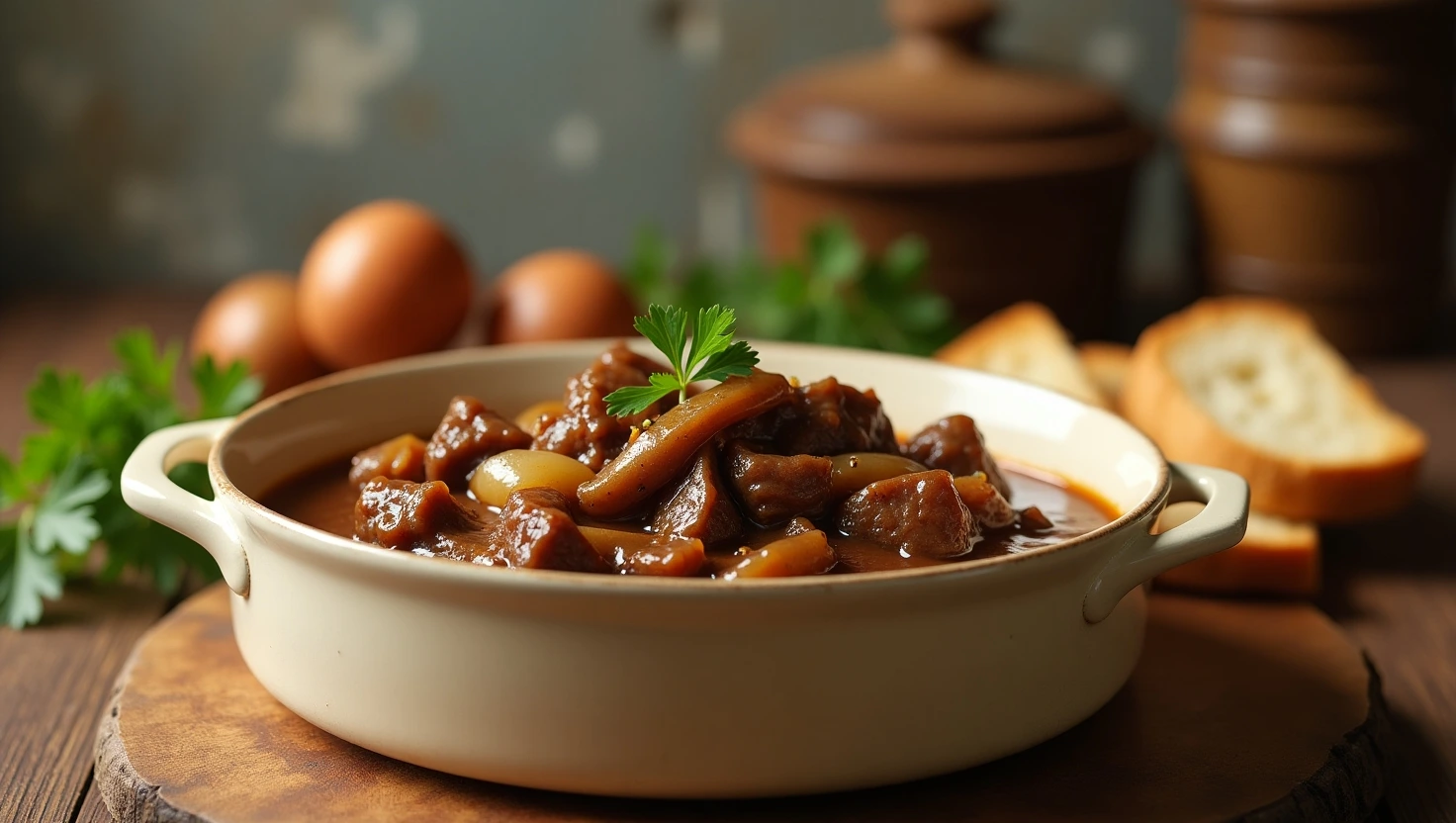Best Homemade Beef Gravy Recipe From Scratch
Nothing warms the dinner table like a rich, velvety beef gravy. It turns simple meals into special memories. Growing up, I watched my grandmother make homemade gravy. She turned simple ingredients into something amazing.
Making the perfect beef gravy from scratch is easier than you think. This homemade gravy is more than a side dish. It’s a flavor boost for roast beef, mashed potatoes, and more.
Whether it’s a Sunday dinner or a holiday feast, this beef gravy recipe will make you a kitchen star. With basic ingredients and simple steps, you’ll create unforgettable meals. Your loved ones will love it.
Table of Contents
Get ready for a tasty adventure in making your own beef gravy. Your taste buds are in for a treat!
What Ingredients Do You Need for Beef Gravy?
Making a tasty beef gravy starts with the right ingredients. Whether you’re cooking at home or in a kitchen, knowing the best ingredients is key. It makes your dish go from good to amazing.
Creating the perfect beef gravy means picking top-notch ingredients. These ingredients work together to make a rich, flavorful sauce. The base of any great gravy is a mix of key elements that turn simple drippings into a dish to remember.
Essential Ingredients for a Rich Gravy
To make a classic beef gravy, you’ll need these basic ingredients:
- Beef broth – the liquid base that provides deep flavor
- Butter – for creating a smooth roux
- All-purpose flour – the primary thickening agent
- Salt and black pepper – essential seasonings
- Beef bouillon – for an extra layer of savory taste
“The secret to great gravy is balance and patience.” – Professional Chef
Optional Additions to Enhance Flavor
Take your beef gravy to the next level with these ingredients:
- Worcestershire sauce – adds depth and umami
- Fresh herbs like thyme or rosemary
- Sautéed mushrooms – for an earthy undertone
- Garlic powder – provides a subtle kick
- Onion powder – enhances overall savoriness
The right mix of beef broth, a good roux, and the right seasonings can make your gravy amazing. Try different ingredients to find your favorite gravy recipe.
Step-by-Step Instructions for Making Beef Gravy
Making the perfect beef gravy is all about technique and detail. It turns simple ingredients into a rich, flavorful sauce. This sauce can make any meal better. To start making homemade gravy, you need to know the basic steps.
Preparing to Make Gravy
First, get your ingredients ready: butter, flour, and pan drippings. Preparation is key for making great gravy. Here’s what you’ll need:
- A medium saucepan
- Whisk
- Measuring cups
- Beef broth or pan drippings
Cooking the Base for Your Gravy
The secret to a perfect gravy is a smooth roux. Start by melting butter in your saucepan over medium heat. Then, add flour slowly while whisking constantly. This mixture is the base of your tasty gravy.
- Melt 4 tablespoons of butter in the saucepan
- Slowly sprinkle in 4 tablespoons of flour
- Whisk continuously for 2-3 minutes
- Gradually pour in pan drippings or beef broth
- Simmer until the gravy reaches desired thickness
Whisk constantly and add liquid slowly. This method makes your gravy smooth and lump-free. Pan drippings add rich flavor, making your gravy stand out.
Tips for Achieving the Perfect Consistency
Creating the ideal beef gravy is all about getting its texture and thickness just right. The right consistency can turn a simple meal into a masterpiece. It adds a rich, hearty flavor that makes everything better.
Knowing how to adjust your gravy’s thickness is key to getting that restaurant-quality taste. Whether it’s too thin or too thick, there are ways to find the perfect balance.
Thinning Your Gravy if It’s Too Thick
Don’t worry if your gravy gets too thick. You have a few options to make it smooth again:
- Gradually whisk in warm beef broth
- Add small amounts of water
- Simmer to naturally reduce thickness
Thickening Methods for a Richer Texture
If your gravy is too thin, try these methods to make it richer:
- Create a cornstarch slurry by mixing cornstarch with cold water
- Incorporate additional roux for depth
- Scrape up browned meat bits from the pan for extra flavor
Patience is important. Slow simmering helps flavors concentrate and thicken your gravy. A perfect gravy balances consistency with a deep, hearty flavor that enhances your dish.
Common Mistakes to Avoid When Making Beef Gravy
Making the perfect beef gravy recipe takes skill and focus. Even seasoned cooks can slip up, affecting the gravy’s quality. Knowing these common mistakes will help you make smooth, tasty beef gravy.

When you’re making your beef gravy, several mistakes can ruin your dish. Paying close attention to your cooking and seasonings is key for a rich, flavorful gravy.
Overcooking the Roux: A Flavor Destroyer
The roux is the base of your gravy, and it needs careful handling. Overcooking can cause several problems:
- Burnt flavor that ruins the entire gravy
- Bitter, acrid taste
- Dark, unappealing color
- Loss of thickening power
The Importance of Proper Seasoning
Seasonings are the heart of your beef gravy. Many cooks under-season or add seasonings too late. To make a memorable gravy:
- Taste your gravy throughout the cooking process
- Add seasonings gradually
- Use fresh herbs and high-quality spices
- Balance salt and other flavor enhancers
Pro tip: Always start with less seasoning and adjust to taste. You can always add more, but you can’t remove excess seasonings once they’re mixed in.
By avoiding these common mistakes, you’ll make your beef gravy truly special. Remember, practice makes perfect. Each batch of gravy is a chance to get better at cooking.
How to Customize Your Beef Gravy
Turning a simple beef gravy into a memorable dish is all about making it your own. Add the right seasonings and techniques to make it stand out. This way, your gravy can become a special dish.
Adding Herbs and Spices for a Unique Flavor
Trying out different seasonings can really change your gravy’s taste. Fresh herbs add bright flavors that go well with beef. Here are some herb mixes to try:
- Classic Herb Blend: Thyme, rosemary, and sage
- Spicy Twist: Smoked paprika and black pepper
- Exotic Touch: Dried oregano and red pepper flakes
Incorporating Pan Drippings for Authenticity
Pan drippings are key to making a rich, authentic gravy. These juices from roasted meat pack a lot of flavor. They can really make your sauce better.
| Technique | Flavor Impact |
|---|---|
| Collect Drippings Immediately | Capture maximum flavor intensity |
| Separate Fat | Prevent gravy from becoming greasy |
| Deglaze Pan | Release caramelized bits for deeper taste |
Pro tip: Be creative with your seasonings and use pan drippings. Each batch can tell a unique story!
Serving Suggestions for Your Beef Gravy
Your homemade beef gravy recipe is a versatile culinary treasure. It can turn ordinary meals into extraordinary dining experiences. With its hearty flavor, this sauce offers countless delicious ways to elevate your favorite dishes.
Delicious Pairings That Complement Gravy
Discover the perfect companions for your beef gravy recipe. They will make your taste buds sing. Some classic pairings include:
- Creamy mashed potatoes
- Roasted beef slices
- Crispy Yorkshire pudding
- Warm buttermilk biscuits
- Fluffy rice
Creative Ways to Use Leftover Gravy
Don’t let your delicious beef gravy go to waste! Get creative with these innovative serving ideas:
- Pour over poutine for a Canadian-inspired treat
- Use as a base for shepherd’s pie
- Mix into savory pot pie filling
- Enhance stews and casseroles
| Dish | Gravy Application | Flavor Enhancement |
|---|---|---|
| Mashed Potatoes | Drizzle generously | Rich, meaty depth |
| Roast Beef Sandwich | Dipping sauce | Intense umami taste |
| Vegetable Casserole | Mixing base | Hearty flavor boost |
Your beef gravy recipe is more than just a sauce—it’s a culinary adventure waiting to be explored. Experiment with these suggestions and discover your favorite way to enjoy this delectable creation.
Storing and Reheating Your Beef Gravy
Keeping your homemade beef gravy fresh is important. It lets you enjoy its flavor for more than one meal. By using the right storage methods, you can keep your gravy tasty and reduce waste.
Safe Storage Strategies
Let your beef gravy cool down before you store it. Put it in an airtight container and seal it well to avoid contamination. You can keep it in the fridge for up to 5 days.
Use glass or ceramic containers with tight lids for the best results.
Reheating Without Losing Flavor
To reheat your gravy, use low heat. Stir it constantly to keep it smooth and prevent it from separating. If it’s too thick, add a bit of broth or water.
Avoid high heat, as it can ruin the gravy’s flavor.
You can also freeze your gravy for up to 3 months. Thaw it in the fridge overnight and reheat it slowly, stirring often. These tips will help you always have tasty homemade gravy on hand.
FAQ
How long can I store homemade beef gravy in the refrigerator?
Homemade beef gravy can stay in the fridge for up to 5 days. Make sure it’s cooled down first. Then, put it in a clean, airtight container to keep it fresh.
Can I freeze beef gravy for later use?
Yes, you can freeze beef gravy for 4-6 months. Use containers or bags made for freezing. When you thaw it, reheat it slowly to keep it smooth.
What’s the best way to prevent lumps when making gravy?
To avoid lumps, slowly add liquid to the roux while whisking. Start with small amounts and keep whisking until it’s fully mixed. If lumps form, strain the gravy to make it smooth.
How can I make my beef gravy more flavorful?
For better flavor, use pan drippings and add herbs like thyme. Try Worcestershire sauce or homemade broth. Mushrooms, red wine, or smoked paprika can also enhance the taste.
What should I do if my gravy is too thick?
If it’s too thick, add a little beef broth or water at a time. Stir well and let it simmer. This way, you can adjust the thickness without making it too thin.
Can I make gravy without pan drippings?
Yes, you can! Use beef broth, butter, flour, and spices. Pan drippings add flavor, but you can get a similar taste with beef base or bouillon.
How do I fix gravy that’s too salty?
If it’s too salty, add more beef broth or water. You can also add cream or a potato to absorb salt. Adjust the seasoning as you taste it.
Tried & Tested: Is Worth It?
There are no reviews yet. Be the first one to write one.

